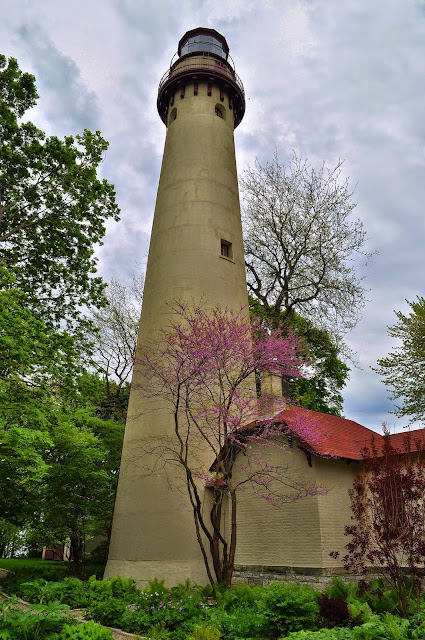
Monday, May 25, 2015
GROSSE POINT LIGHTHOUSE-EVANSTON, ILLINOIS
The twenty-five-foot bluff on which the lighthouse was built had been known as Grosse Point (great point) since French fur trappers frequented the area in the seventeenth century. Explorer and Jesuit Missionary Jacques Marquette recorded camping on “Grosse Pointe” on December 3 during his 1674 expedition to what would become Chicago. On the night of September 7, 1860, the Lady Elgin was northbound from Chicago carrying Irish Union Guards returning to Milwaukee after hearing a campaign speech by Stephen A. Douglas, Abraham Lincoln’s opponent in the presidential election. When off Grosse Point, the Lady Elgin was rammed just aft of its side paddlewheel by the lumber-laden schooner Augusta, and within twenty minutes, the steamship had split apart and sunk. When day broke, many of the surviving passengers and crew were drifting in stormy waters, clinging to pieces of the wreckage. Students from nearby Northwestern University gathered on the shore, scanning the water for signs of life. One student, Edward W. Spencer, rescued seventeen people before collapsing from overexertion and exposure, and a plaque honoring his effort can be seen in the Northwestern University Library. Nearly 300 lives were lost with the sinking of the Lady Elgin, making it the worst maritime disaster on the Great Lakes up to that time. Other shipwrecks occurred off Grosse Point during the next decade, spurring the residents of Evanston to petition Congress for a lighthouse. In 1871, Congress appropriated $35,000 for a lighthouse on Grosse Point, and a 100 by 550-foot site was purchased for $1,200. Orlando Metcalfe Poe was appointed Chief Engineer of the Upper Great Lakes Lighthouse District in 1870, and in this capacity designed many of the tall, graceful brick towers that adorn the Great Lakes. Poe drew up plans and specifications for Grosse Point Lighthouse in 1872, and after proposals for the construction of the station were solicited by advertisement, they were opened on August 13, 1872. The lowest bid was accepted, and the excavation for the foundations of the tower, covered way, and dwelling commenced in September. By the end of the working season in November, the stonework of the dwelling had been brought up to ground level. Work resumed the following April, and over a two-month period the brickwork of the dwelling was nearly completed and ninety-one piles were driven to a depth of fifteen feet and overlaid by a four-foot-thick concrete footing to support the tower. By the end of June, the passageway, the stonework for the tower’s foundation, and the outside of the dwelling were nearly completed. During the rest of the year, the 113-foot-tall brick tower, which tapers from a diameter of twenty-two feet at its base to thirteen feet three inches at the parapet, gradually rose above the attached dwelling. A second-order Fresnel lens, manufactured in Paris by Henry-Lepaute, was installed in the lantern room, and the light was activated on March 1, 1874. Three panels of red glass were slowly rotated around the fixed lens by a clockwork mechanism powered by a sixty-pound weight that was suspended within the tower’s double walls. The light’s characteristic was fixed white, varied by a ten-second red flash every three minutes. A second-order Fresnel lens is the largest size every used on the Great Lakes, and Grosse Point’s second order lens was the first one installed on the lakes and the only one that remains active today. Due to deterioration of the bricks used to construct the lighthouse, scaffolding was erected around the tower in 1914, and it was encased in reinforced concrete at a cost of $2,679. In 1934, the station was electrified, and the fog signal was discontinued. These actions allowed the light to be operated by a photoelectric cell, and the last keeper left the station in 1935. ). Reactivated (inactive 1941-1946, now privately maintained); focal plane 119 ft (36 m); 2 white flashes every 15 s. 113 ft (34 m).
Newly finished Grosse point Lighthouse-Photograph courtesy of National Archives
Photograph courtesy National Archives
Subscribe to:
Post Comments (Atom)





No comments:
Post a Comment